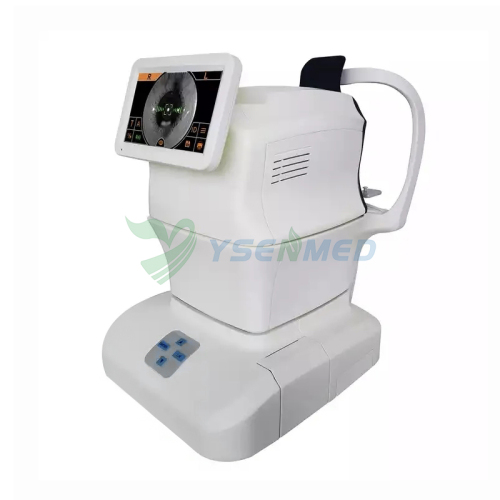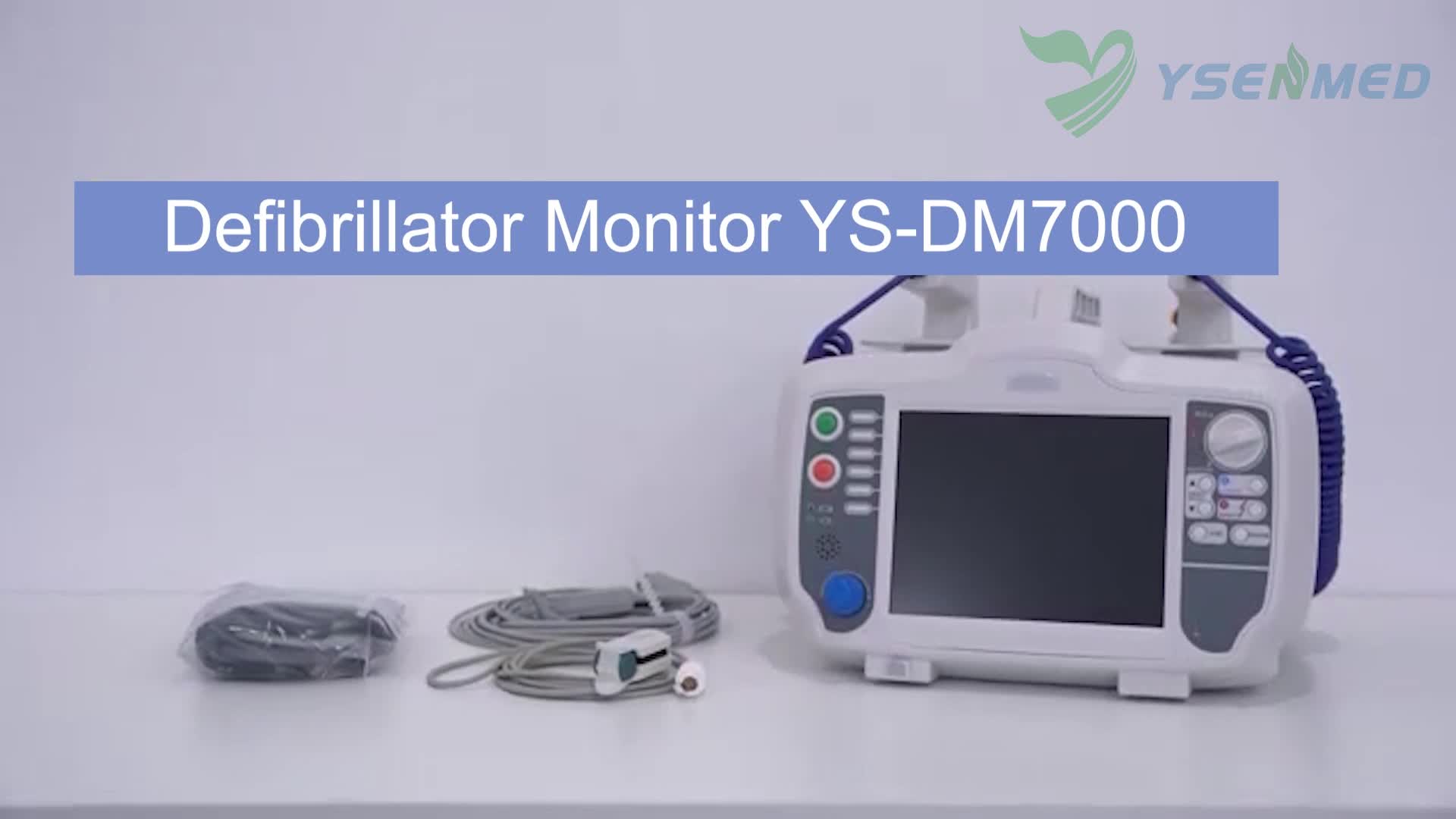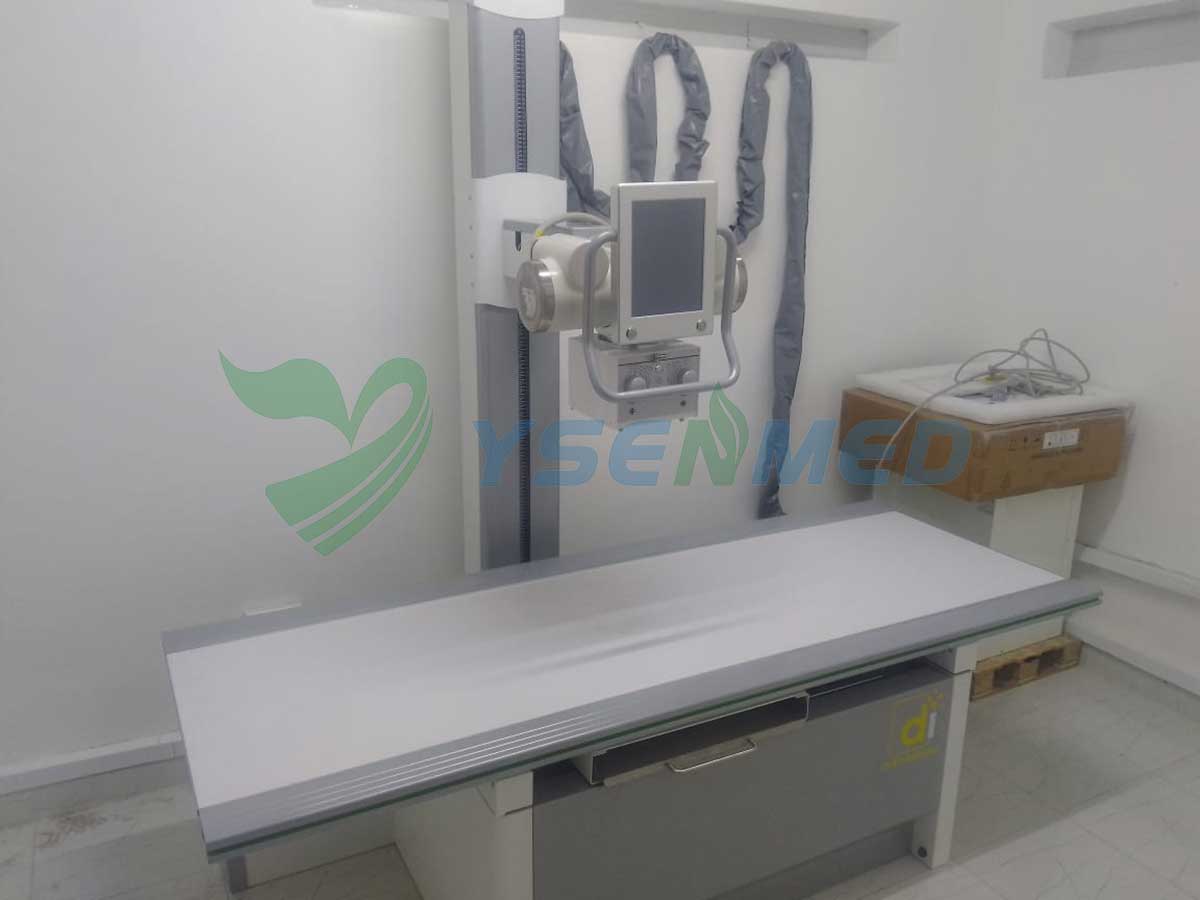Hot Products
YSX500D 50kW DR system set up and put into service in Cambodia.
YSENMED YSX500D 50kW digital x-ray system has been successfully set up and put into service in a hospital in Cambodia.
YSX056-PE serving as a vehicle-mounted x-ray in the Philippines
YSX056-PE 5.6kW portable x-ray unit has been adapted to fit on a truck, to provide mobile x-ray examination service for remote communities in the Philippines.
X Ray Machine To Zimbabwe
x ray machine, 50KW x ray machine
Microscope To Malawi
Achromatic objectives: 4X、10X、40X(S), 100X(S、Oil) Wide field eyepiece: WF10X(WF16X for option) Eyepiece head: Sliding binocular head inclined at 45° Stage: Double layer mechanical stage size 140X140mm, moving range 75X45mm Focusing: Coaxial coarse and
A Breath of Fresh Air: Why Non-Contact Tonometer is Preferred by Eye Care Professionals
Views : 2338
Update time : 2024-05-23 14:22:00
Introduction:
As an eye care professional, I've seen the tremendous impact that advancements in technology have had on the way we diagnose and manage eye health. One of the most significant developments in recent years has been the rise of the non-contact tonometer, a revolutionary tool that has transformed the way we measure intraocular pressure (IOP). In this article, we'll delve into the reasons why non-contact tonometry has become the preferred method for eye care professionals around the world.

What is a Non-Contact Tonometer?
A non-contact tonometer, also known as an air-puff tonometer, is a device used to measure the pressure inside the eye, or intraocular pressure (IOP). This measurement is crucial in the diagnosis and management of a wide range of eye conditions, including glaucoma, a leading cause of blindness worldwide.
Unlike traditional contact tonometers, which require the clinician to physically touch the patient's eye with a probe, non-contact tonometers use a gentle puff of air to temporarily deform the cornea, the clear front part of the eye. This process allows the device to measure the eye's resistance to the air puff, which directly correlates to the IOP. The entire measurement is quick, painless, and does not require any direct contact with the eye.
Advantages of Non-Contact Tonometry
1. Improved Patient Comfort and Compliance
One of the primary advantages of non-contact tonometry is the increased comfort and ease it offers patients. Traditional contact tonometry can be an unpleasant experience, as the probe makes direct contact with the sensitive surface of the eye. This can cause discomfort, tearing, and even a temporary blurred vision in some patients. The gentle air puff used by non-contact tonometers, on the other hand, is widely regarded as a more comfortable and tolerable procedure, making it easier for patients to comply with regular eye exams and IOP measurements.
2. Reduced Risk of Infection
Another significant benefit of non-contact tonometry is the reduced risk of cross-contamination and infection. With traditional contact tonometers, there is a possibility of transferring bacteria or other pathogens from one patient to another if the probe is not properly sterilized between uses. The non-contact nature of air-puff tonometers eliminates this risk, as there is no direct contact with the eye, reducing the potential for the spread of infectious diseases.
3. Faster and More Efficient Measurements
Compared to their contact counterparts, non-contact tonometers are generally faster and more efficient in obtaining IOP readings. The entire measurement process typically takes just a few seconds, allowing eye care professionals to quickly and accurately assess a patient's eye pressure without the need for extensive patient preparation or lengthy examination times. This efficiency can lead to shorter wait times for patients and improved workflow for the clinic.
4. Increased Accuracy and Repeatability
Despite their non-contact approach, non-contact tonometers have been shown to provide highly accurate and repeatable IOP measurements. Studies have consistently demonstrated that the readings obtained from non-contact tonometers are comparable, if not superior, to those from traditional contact tonometers, with a high degree of correlation between the two methods. This level of accuracy is crucial for the early detection and effective management of conditions like glaucoma.
5. Suitability for a Wider Range of Patients
Non-contact tonometry is particularly well-suited for patients who may have difficulty undergoing traditional contact tonometry, such as children, individuals with sensitivities or conditions affecting the eye surface, and those wearing contact lenses. The non-invasive nature of the air-puff method makes it a more accessible option for these patient populations, ensuring that they can receive the necessary eye care and IOP monitoring.
Integrating Non-Contact Tonometry into Eye Care Practices
Given the numerous advantages of non-contact tonometry, it's no surprise that this technology has become increasingly prevalent in eye care practices around the world. Many leading ophthalmologists and optometrists have embraced the use of non-contact tonometers, recognizing the benefits they provide for both patients and clinicians.
When integrating non-contact tonometry into a practice, it's important to ensure that the chosen device is of high quality, reliable, and easy to use. Factors such as measurement accuracy, device portability, and user-friendly interfaces should be carefully considered to ensure a seamless integration and a positive experience for both the clinician and the patient.
Additionally, proper training and education for the clinical staff are essential to ensure that the non-contact tonometer is used effectively and that the IOP readings are properly interpreted and incorporated into the overall patient care plan.
Conclusion
The rise of non-contact tonometry has marked a significant shift in the way eye care professionals approach the measurement of intraocular pressure. This innovative technology offers a range of benefits, including improved patient comfort, reduced infection risk, faster and more efficient measurements, and increased accuracy and repeatability.
As an eye care professional, I've witnessed firsthand the transformative impact of non-contact tonometry on the way we diagnose and manage eye health. By embracing this technology and integrating it into our practices, we can provide our patients with a more comfortable, efficient, and accurate experience, ultimately leading to better outcomes and a higher standard of eye care.
In the ever-evolving landscape of ophthalmology and optometry, non-contact tonometry stands as a shining example of how advancements in technology can truly make a difference in the lives of our patients. As we continue to push the boundaries of what's possible in eye care, I'm confident that the non-contact tonometer will remain a vital tool in our arsenal, helping us to deliver the highest quality of care and a breath of fresh air to our patients.
FAQs
What is the main advantage of using a non-contact tonometer over a traditional contact tonometer?
The primary advantage of using a non-contact tonometer is the increased comfort and ease it offers patients. Traditional contact tonometers involve direct physical contact with the sensitive surface of the eye, which can cause discomfort, tearing, and even temporary blurred vision. In contrast, the gentle air puff used by non-contact tonometers is widely regarded as a more comfortable and tolerable procedure, making it easier for patients to comply with regular eye exams and intraocular pressure (IOP) measurements.
How accurate are the IOP readings from a non-contact tonometer compared to a traditional contact tonometer?
Studies have consistently shown that the IOP readings obtained from non-contact tonometers are highly accurate and comparable, if not superior, to those from traditional contact tonometers. The correlation between the two methods is generally very high, ensuring that non-contact tonometry provides a reliable and accurate assessment of a patient's eye pressure, which is crucial for the early detection and effective management of conditions like glaucoma.
What are the benefits of the non-contact nature of a non-contact tonometer?
Besides improved patient comfort, the non-contact nature of air-puff tonometers offers several other benefits. It significantly reduces the risk of cross-contamination and infection, as there is no direct contact with the eye, eliminating the potential for transferring bacteria or other pathogens from one patient to another. Additionally, the non-contact approach makes non-contact tonometry a more suitable option for a wider range of patients, including children, individuals with eye sensitivities or conditions, and those wearing contact lenses.
As an eye care professional, I've seen the tremendous impact that advancements in technology have had on the way we diagnose and manage eye health. One of the most significant developments in recent years has been the rise of the non-contact tonometer, a revolutionary tool that has transformed the way we measure intraocular pressure (IOP). In this article, we'll delve into the reasons why non-contact tonometry has become the preferred method for eye care professionals around the world.

What is a Non-Contact Tonometer?
A non-contact tonometer, also known as an air-puff tonometer, is a device used to measure the pressure inside the eye, or intraocular pressure (IOP). This measurement is crucial in the diagnosis and management of a wide range of eye conditions, including glaucoma, a leading cause of blindness worldwide.
Unlike traditional contact tonometers, which require the clinician to physically touch the patient's eye with a probe, non-contact tonometers use a gentle puff of air to temporarily deform the cornea, the clear front part of the eye. This process allows the device to measure the eye's resistance to the air puff, which directly correlates to the IOP. The entire measurement is quick, painless, and does not require any direct contact with the eye.
Advantages of Non-Contact Tonometry
1. Improved Patient Comfort and Compliance
One of the primary advantages of non-contact tonometry is the increased comfort and ease it offers patients. Traditional contact tonometry can be an unpleasant experience, as the probe makes direct contact with the sensitive surface of the eye. This can cause discomfort, tearing, and even a temporary blurred vision in some patients. The gentle air puff used by non-contact tonometers, on the other hand, is widely regarded as a more comfortable and tolerable procedure, making it easier for patients to comply with regular eye exams and IOP measurements.
2. Reduced Risk of Infection
Another significant benefit of non-contact tonometry is the reduced risk of cross-contamination and infection. With traditional contact tonometers, there is a possibility of transferring bacteria or other pathogens from one patient to another if the probe is not properly sterilized between uses. The non-contact nature of air-puff tonometers eliminates this risk, as there is no direct contact with the eye, reducing the potential for the spread of infectious diseases.
3. Faster and More Efficient Measurements
Compared to their contact counterparts, non-contact tonometers are generally faster and more efficient in obtaining IOP readings. The entire measurement process typically takes just a few seconds, allowing eye care professionals to quickly and accurately assess a patient's eye pressure without the need for extensive patient preparation or lengthy examination times. This efficiency can lead to shorter wait times for patients and improved workflow for the clinic.
4. Increased Accuracy and Repeatability
Despite their non-contact approach, non-contact tonometers have been shown to provide highly accurate and repeatable IOP measurements. Studies have consistently demonstrated that the readings obtained from non-contact tonometers are comparable, if not superior, to those from traditional contact tonometers, with a high degree of correlation between the two methods. This level of accuracy is crucial for the early detection and effective management of conditions like glaucoma.
5. Suitability for a Wider Range of Patients
Non-contact tonometry is particularly well-suited for patients who may have difficulty undergoing traditional contact tonometry, such as children, individuals with sensitivities or conditions affecting the eye surface, and those wearing contact lenses. The non-invasive nature of the air-puff method makes it a more accessible option for these patient populations, ensuring that they can receive the necessary eye care and IOP monitoring.
Integrating Non-Contact Tonometry into Eye Care Practices
Given the numerous advantages of non-contact tonometry, it's no surprise that this technology has become increasingly prevalent in eye care practices around the world. Many leading ophthalmologists and optometrists have embraced the use of non-contact tonometers, recognizing the benefits they provide for both patients and clinicians.
When integrating non-contact tonometry into a practice, it's important to ensure that the chosen device is of high quality, reliable, and easy to use. Factors such as measurement accuracy, device portability, and user-friendly interfaces should be carefully considered to ensure a seamless integration and a positive experience for both the clinician and the patient.
Additionally, proper training and education for the clinical staff are essential to ensure that the non-contact tonometer is used effectively and that the IOP readings are properly interpreted and incorporated into the overall patient care plan.
Conclusion
The rise of non-contact tonometry has marked a significant shift in the way eye care professionals approach the measurement of intraocular pressure. This innovative technology offers a range of benefits, including improved patient comfort, reduced infection risk, faster and more efficient measurements, and increased accuracy and repeatability.
As an eye care professional, I've witnessed firsthand the transformative impact of non-contact tonometry on the way we diagnose and manage eye health. By embracing this technology and integrating it into our practices, we can provide our patients with a more comfortable, efficient, and accurate experience, ultimately leading to better outcomes and a higher standard of eye care.
In the ever-evolving landscape of ophthalmology and optometry, non-contact tonometry stands as a shining example of how advancements in technology can truly make a difference in the lives of our patients. As we continue to push the boundaries of what's possible in eye care, I'm confident that the non-contact tonometer will remain a vital tool in our arsenal, helping us to deliver the highest quality of care and a breath of fresh air to our patients.
FAQs
What is the main advantage of using a non-contact tonometer over a traditional contact tonometer?
The primary advantage of using a non-contact tonometer is the increased comfort and ease it offers patients. Traditional contact tonometers involve direct physical contact with the sensitive surface of the eye, which can cause discomfort, tearing, and even temporary blurred vision. In contrast, the gentle air puff used by non-contact tonometers is widely regarded as a more comfortable and tolerable procedure, making it easier for patients to comply with regular eye exams and intraocular pressure (IOP) measurements.
How accurate are the IOP readings from a non-contact tonometer compared to a traditional contact tonometer?
Studies have consistently shown that the IOP readings obtained from non-contact tonometers are highly accurate and comparable, if not superior, to those from traditional contact tonometers. The correlation between the two methods is generally very high, ensuring that non-contact tonometry provides a reliable and accurate assessment of a patient's eye pressure, which is crucial for the early detection and effective management of conditions like glaucoma.
What are the benefits of the non-contact nature of a non-contact tonometer?
Besides improved patient comfort, the non-contact nature of air-puff tonometers offers several other benefits. It significantly reduces the risk of cross-contamination and infection, as there is no direct contact with the eye, eliminating the potential for transferring bacteria or other pathogens from one patient to another. Additionally, the non-contact approach makes non-contact tonometry a more suitable option for a wider range of patients, including children, individuals with eye sensitivities or conditions, and those wearing contact lenses.
Related News
Read More >>
 Is a Radiant Heater Good for Babies?
Is a Radiant Heater Good for Babies?
May .11.2025
In this article, we'll dive deep into radiant heaters, their benefits, potential drawbacks, and tips for safe use.
 How Long Can a Baby Stay in an Incubator?
How Long Can a Baby Stay in an Incubator?
May .10.2025
How long can a baby stay in an incubator? Let’s dive into this topic, from the reasons for incubator use to what parents can expect during their little one's stay.
 Introduction video of YSENMED YS-DM7000 Defibrillator Monitor
Introduction video of YSENMED YS-DM7000 Defibrillator Monitor
May .02.2025
Here we share the introduction video of YSENMED YS-DM7000 Defibrillator Monitor.
 Kenyan distributor sets up YSX500D DR system and considers re-purchase.
Kenyan distributor sets up YSX500D DR system and considers re-purchase.
May .01.2025
Our Kenyan distributor has successfully set up the YSX500D 50kW digital x-ray system in a hospital, and considers purchasing another 32kW x-ray system.



